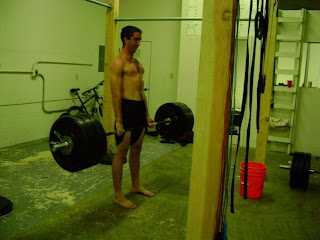The second trait which identifies most intermediate CrossFitters is an increased necessity for developing capacity in weaknesses. The intermediate CrossFitter is "comfortable" with the pain of a CrossFit workout - they have accepted that it will hurt and can push themselves through it regularly. Where the novice athlete struggles simply with the pain and intensity of CrossFit, the intermediate athlete will start seeing plateaus due not to their inability to cope with the intensity, but with specific movements and weaknesses that hold them back during the WOD.
There are two types of capacity that need to be developed: technical capacity, and physical capacity. In practice, there is a lot of overlap between technical and physical capacity; as Coach Glassman would say, "nature does not make these distinctions." However, they can be useful terms for our discussion, so we'll define them.
Technical capacity is the athletes ability to perform a movement safely and efficiently under light loading and/or at low intensity(see Part 1 for definitions of safety and efficiency).
Physical capacity is the athletes ability to perform a movement safely and efficiently under heavy load and/or at high intensity.
Technical capacity is a necessary prerequisite for physical capacity, because if an athlete can't perform a movement safely and efficiently at low load/intensity, he will necessarily not be able to do so at high load/intensity.
As you may have guessed, there is a difference in how we approach development of these capacities. Neurological capacity is addressed through practice, and physical capacity is addressed through training (see "What defines the Intermediate CrossFitter" for defintions of practice and training.)
Let's look at some ways to develop both technical and physical capacity in two very different movements that plenty of athletes have trouble with: the squat clean, and running.
Before we get into it, let's create two imaginary athletes. Because I'm very creative, we'll call them Athlete A and Athlete B.
Athlete A:
Squat - 315#
Press - 185#
Deadlift - 405#
Squat Clean - 155#
400m run - 1:35
1 mile run - 7:45
Athlete B
Squat - 225#
Press - 125#
Deadlift - 275#
Squat clean - 155#
400m run - 1:10
1 mile run - 6:00
Athlete A's problem with the squat clean is pretty clearly not an issue of physical capacity: he is strong enough in the slow lifts that 155# should be a light clean for him. This means that his problem is technical, and should be addressed through practice - low intensity work emphasizing form.
Athlete B's problem with the squat clean is probably not a strength issue: all his lifting numbers are low. A 155# squat clean fits in pretty well with his other lifts, which means that all his lifts need to get stronger if his squat clean is going to get heavier. Athlete B needs more training in the lifts - heavy load/high intensity time on the barbell. A good option would be something like the CrossFit Strength Bias Program, available in the CrossFit Journal.
Athlete A has picture perfect POSE running form. He leans forward at the ankle, his foot lands directly under his body, and the weight is on the mid foot. But even with this high level of technical capacity, he's running a 7:45 mile and a 1:35 400m. There are two types of physical capacity we want to develop: speed (how fast he can run) and cardiorespiratory endurance (the ability of body systems to gather, process, and deliver oxygen, in this case specifically while running.)
To develop speed, Athlete A needs to spend time doing short sprints (between 40-200m) with full recovery in between efforts, focusing on moving as fast as possible. Essentially, this type of training should be treated in the same manner as a heavy lifting day. Every effort is very high intensity, and I cannot overemphasize the importance of full recovery between attempts.
If the disease is poor endurance, hard interval work is the cure. Workouts like 400m run/2 minute rest x 4, 800m run/5 minute rest x 4, tabata sprints, and the occasional longer run (1-3 miles) will do the trick.
Athlete B is running a 6:00 mile and a 1:10 400m. These are pretty good times, but we know Athlete B could be running a lot faster, because as he runs, he reaches his feet in front of him, slams his heels into the ground and pushes off, his head is bouncing, and his torso is swiveling. In other words, he's doing everything wrong. Athlete B needs to spend time practicing his running technique at low intensity to develop efficient form.
For ideas on how to organize your skill practice, see Part 1.
Next post will be "Advancing The Intermediate CrossFiter, Part 3: What to do when progress stops.
Post thoughts, questions, and suggestions to comments.
